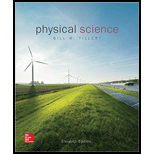
Concept explainers
To complete: From the following options, an empirical formula does not:
identify elements in a compound.
identify actual numbers of atoms in a molecule.
provide the simplest whole number ratio of atoms ofelements with subscripts.
provide the formula for an ionic compound.
Answer to Problem 1AC
Solution:
Option (b) is correct.
Explanation of Solution
Introduction:
There are a number of compounds in this world. In order to simplify the name of each compound a short term formula is given to each element or ion. It is of three types: Structural formula, empirical formula and molecular formula.
Explanation:
Reason for the correct option:
A formula which contains the elements in the simplest ratio is called an empirical formula. It identifies the elements in a compound. It represents the simplest whole number ratio of atoms of elements with subscripts. It also provides the formula of an ionic compound. The actual number of atoms present in a compound is given by molecular formula not empirical formula.
Hence, option (b) is correct.
Reason for the incorrect options:
Option (a) is incorrect becauseempirical formula identifies the elements present in a compound. For example: The empirical formula of ethanol is
Option (c) is incorrect because it gives the simplest whole number of atoms of a compound. The empirical formula of ethanol is
Option (d) is incorrect because it provides the formula of ionic compound. So it is a wrong answer.
Hence, options (a), (c) and (d) are incorrect.
Conclusion:
The empirical formula does not identify the actual numbers of atoms in a molecule.
Want to see more full solutions like this?
Chapter 10 Solutions
Physical Science - With Lab Manual
- State the short general principle of solubility, and explain what it means.arrow_forwardSuppose you are given the volume (in liters) of a salt (NaCl) solution and its molarity. Explain how you would determine the moles of salt in this solution.arrow_forward4. In a few sentences, relate the amounts of energy needed to heat the cold and hot water with the amounts of time that it took to heat each sample. Do the results make sense? Why?arrow_forward
 An Introduction to Physical SciencePhysicsISBN:9781305079137Author:James Shipman, Jerry D. Wilson, Charles A. Higgins, Omar TorresPublisher:Cengage Learning
An Introduction to Physical SciencePhysicsISBN:9781305079137Author:James Shipman, Jerry D. Wilson, Charles A. Higgins, Omar TorresPublisher:Cengage Learning Physics for Scientists and Engineers, Technology ...PhysicsISBN:9781305116399Author:Raymond A. Serway, John W. JewettPublisher:Cengage Learning
Physics for Scientists and Engineers, Technology ...PhysicsISBN:9781305116399Author:Raymond A. Serway, John W. JewettPublisher:Cengage Learning

